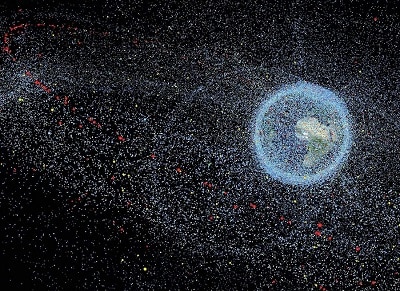
A new analysis has found that the threat posed by space debris to satellites in geosynchronous Earth orbits (GEO) is much greater than has been assumed until now. Daniel Oltrogge at Analytical Graphics Inc (AGI), and collaborators at AGI and satellite operators SES and Inmarsat, used six separate approaches to estimate the risk, finding broad agreement between them. The results indicate that the chances of collision in GEO are up to four orders of magnitude higher than some estimates have suggested, and those collisions can occur at much higher relative velocities than previously thought. The researchers predict that the population of active GEO satellites can be expected to suffer one potentially mission-terminating impact every four years on average.
Desirable orbits
Because objects in GEO circle the Earth once every 24 hours, GEO satellites with circular, equatorial orbits keep a constant position over the Earth’s surface. Such orbits – about 35,786 km above the ground – are especially useful for communications satellites, since ground stations can maintain contact without the need for active tracking.
Unfortunately, the desirability of this orbital real estate has led to the GEO region above the equator becoming congested with satellites both operational and defunct, as well as smaller “resident space objects” (RSOs) generated by collisions, explosions, and other fragmentation events. This means that, in addition to the 466 active GEO satellites, the region is also host to thousands of objects larger than 10 cm, and at least tens of thousands larger than 1 cm.
Risk assessment
“Collision risk is significant in all orbit regimes, but too often people gravitate toward low Earth orbit (LEO) and fail to properly assess the risk at GEO. This research is intended to open that discussion, particularly as GEO is where the majority of space commerce is currently conducted,” says Oltrogge, who presented the work at the 68th International Astronautical Congress in Adelaide, Australia in September 2017.
Assessing the hazard is more challenging for GEO than it is for LEO for various reasons: the number of orbiting objects is harder to establish with confidence; orbits tend to be largely synchronous; and the population of active satellites is distributed unevenly around the equator. Still, researchers have produced a range of estimates for the danger, with those at the bottom end going so far as to suggest that the risk of collision is so low that even the routine use of graveyard orbits for retired GEO satellites is unnecessary. When they do occur, impacts have generally been assumed to involve relative velocities below 1 km/s.
The methods used by Oltrogge and colleagues involved statistical extrapolation from catalogues of known debris, records of close approaches, and simulations of the passage of satellites through known and estimated RSO populations. The analyses included orbital drift induced by the gravitational effects of the Sun and Moon, and also took account of the elongated shape and alignment of the typical GEO satellite. “An important element of the process was the corroboration that each of the many independent approaches provides to the others,” explains Oltrogge. “The collective body of work is more impactful than each of the parts on their own, and consequently we thought that having them all done and published in a single paper was worth the extra time.”
Surprisingly hazardous
The researchers found that the average time between satellite–debris collisions is just four years for the population of RSOs 1 cm across, but this was not the only alarming result. The team also found that, contrary to previous analyses, collisions could take place at relative velocities of up to 4 km/s, due to the existence of GEO-crossing debris in eccentric orbits. Such impacts are energetic enough to cause catastrophic damage to satellites, which are not designed with mechanical robustness in mind.
“GEO satellites are essentially sitting ducks,”
Hanspeter Schaub, University of Colorado Boulder
Collisions with objects 20 cm in size were inferred to occur every 50 years on average, and events like this can produce clouds of high-velocity fragments that spread throughout the GEO region, potentially triggering a cascade of secondary impacts. “While the relative speeds are not as high as what can be encountered in LEO, they are plenty large to completely fractionate a spacecraft,” says Hanspeter Schaub of University of Colorado Boulder, who was not involved in this study. Furthermore, continues Schaub, “In contrast to low Earth orbits, the GEO satellites are essentially sitting ducks with limited ability to evade the space debris flow.”
Suspected events
But if we should expect collisions among GEO satellites to be commonplace, one might wonder why we hear so little about them. In fact, although only two such events have ever been confirmed, a further 20 or more are suspected. Additionally, optical surveys by ESA found large numbers of objects that can only have originated from unreported fragmentation events.
It does seem, then, that the GEO region might well be a much more hazardous environment for satellites than assumed. “Our findings indicate that unmitigated collision risk is fairly high,” says Oltrogge. “Although there is plenty of GEO satellite redundancy to weather a single mission-terminating collision with a debris fragment, of far greater consequence are GEO collisions with larger debris objects; all in the industry need to ensure that effective mitigation measures are implemented to avoid placing the entire market for GEO-based satellite services at risk.”
Schaub agrees with the importance of the research: “This study is very timely, as the geosynchronous region is the most heavily insured region in space. Oltrogge et al. provide an excellent overview of the limited research in GEO debris risks, and summarize extensive new work illustrating the challenge of GEO debris.”



